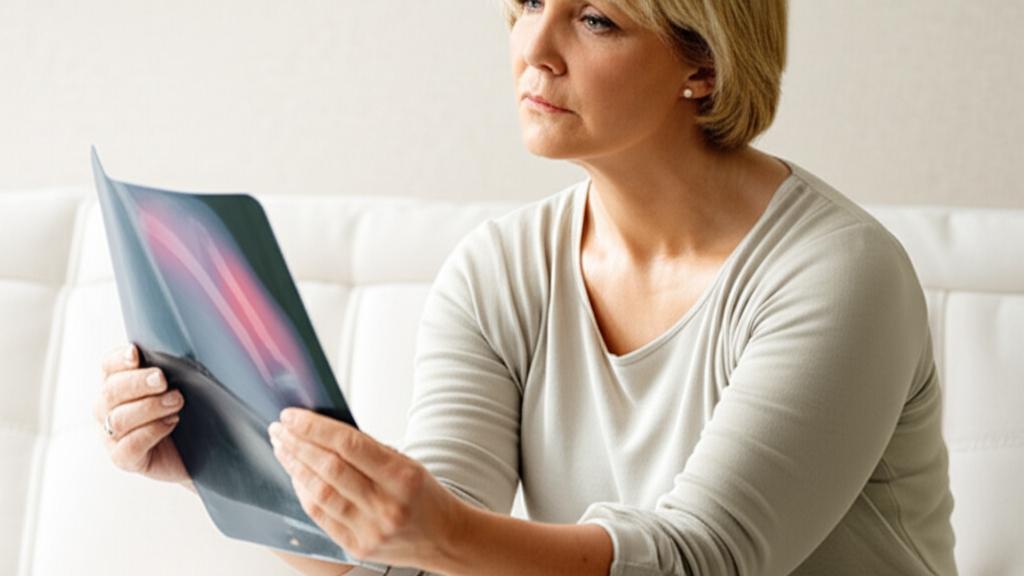I remember a patient, let’s call her Susan. She came in for her regular check-up, feeling perfectly fine, energetic even. We chatted, went through the usual, and because of her age and being post-menopause, I suggested a bone density scan. The result? Osteopenia. Susan was surprised. “But I feel strong, Doctor!” she said. And that’s often the way with osteopenia; it’s a bit of a quiet condition. It means your bones have lost some of their usual mineral oomph, making them not quite as dense as they ideally should be. Think of it as your bones being a little less sturdy than they once were.
This isn’t osteoporosis yet, which is more severe bone thinning, but it’s like an early heads-up. It’s actually pretty common. Many folks, especially as we get past 50, start to see some changes in bone density.
Understanding Osteopenia: What It Means for Your Bones
So, what’s the difference between osteopenia and its more well-known cousin, osteoporosis? Well, osteopenia is really that first whisper that your bones are losing density. It’s the stage before osteoporosis. If we don’t pay attention to osteopenia, it can progress to osteoporosis. And with osteoporosis, bones become much weaker, meaning a simple fall could lead to a fracture, something we really want to avoid.
It’s estimated that over 40 million people in the U.S. might have osteopenia, and about a third of adults over 50 are dealing with some level of bone density loss. It’s more common than you might think.
The Silent Signs (Or Lack Thereof)
Here’s the tricky part: osteopenia itself usually doesn’t come with any big, flashing symptoms. You likely won’t feel your bones getting less dense. That’s why we often call osteopenia and osteoporosis “silent diseases.” You might not know you have it until we specifically look for it, or, unfortunately, until a minor incident causes an unexpected break.
What Causes Our Bones to Thin?
Most of the time, osteopenia is a natural part of aging. Our bones, believe it or not, are living, changing tissues. They’re constantly rebuilding themselves. Around age 25, our bones are at their peak density. After that, the breakdown process can start to outpace the rebuilding process. For many, this slow decline is no big deal. But if you lose too much density, that’s when osteopenia can develop, signaling a higher chance of osteoporosis down the road.
Are You at Higher Risk?
While anyone can develop osteopenia, some factors can make it more likely. These include:
- Being over 50. It’s just one of those things that can happen as we get older.
- Being female. Women, especially after menopause, are about four times more likely to experience it due to hormonal changes.
- Lifestyle choices like smoking or regularly having more than a couple of alcoholic drinks a day.
- Certain health conditions can also play a role:
- An overactive thyroid (hyperthyroidism)
- Diabetes
- Chronic kidney disease (CKD)
- Not getting enough calcium or vitamin D
- Hormonal imbalances, like Cushing syndrome
- Eating disorders like anorexia
- Some autoimmune diseases that affect bones, such as rheumatoid arthritis.
- Some medications can also contribute, such as:
- Certain diuretics
- Long-term use of corticosteroids
- Some medications for seizures
- Hormone therapies for cancers like breast or prostate cancer
- Anticoagulants (blood thinners)
- Proton pump inhibitors (PPIs), often used for acid reflux, which can affect how your body absorbs calcium.
What Are the Complications?
The main concern with osteopenia is that it increases your risk of bone fractures and the chance of it progressing to full-blown osteoporosis. While osteopenia itself might not cause pain, weaker bones are simply more vulnerable.
How We Find Out: Diagnosing Osteopenia
If I suspect osteopenia, or if you’re in an age group where screening is recommended, we’ll talk about a bone density test. This is a simple, painless imaging test, a bit like a special X-ray, that measures the mineral content in your bones, usually in your hip and spine. It gives us a “T-score,” which tells us how your bone density compares to that of a healthy young adult.
We usually start suggesting these screenings for women around age 50 or after menopause, and for men typically after age 70, or earlier if there are significant risk factors or a family history of osteoporosis. If we do find osteopenia, we’ll likely want to check your bone density every few years to see how things are changing.
Taking Action: Treating Osteopenia
The great news is there’s a lot we can do! Our main goals with osteopenia treatment are to slow down further bone loss, strengthen your existing bone tissue, and, most importantly, prevent fractures and stop it from turning into osteoporosis.
Here’s what we often recommend:
- Getting Active: Regular physical activity is a fantastic bone booster. We’re especially fond of weight-bearing exercises – things like walking, jogging (if your joints are up for it!), dancing, or even climbing stairs. Activities like yoga, Pilates, and tai chi are also wonderful because they improve strength and balance, which can help prevent falls. Sometimes, I’ll suggest working with a physical therapist to find the safest and most effective exercises for you.
- Vitamins and Minerals: Your bones love calcium and vitamin D. We might talk about supplements, either over-the-counter or sometimes prescription strength, depending on your levels and needs. I’ll help you figure out the right type and dose.
- Eating for Bone Health: A balanced diet rich in calcium (think dairy, leafy greens, fortified foods) and vitamin D (fatty fish, egg yolks, fortified foods) is key. Sometimes, a chat with a registered dietitian can be really helpful to create an eating plan that supports your bones and overall health.
For osteopenia itself, we usually don’t jump to prescription medications unless the risk of fracture is quite high or it’s progressing quickly. Those are more commonly used if osteoporosis develops.
What to Expect and Can We Turn It Around?
If you have osteopenia, expect to keep an eye on your bone density with tests every few years. Now, for the big question: can osteopenia be reversed? While it’s a natural process of bone loss, you absolutely can slow it down significantly. The earlier we catch it, the better our chances of preventing osteoporosis. Some people, with dedicated lifestyle changes, can even see an improvement in their bone density. It’s quite encouraging!
Can We Prevent Osteopenia Altogether?
It’s tough to completely prevent the natural bone loss that comes with age. But, many of the things we do to treat osteopenia are also the best ways to keep your bones as strong as possible for as long as possible. If you’re worried about your bone health, let’s chat about what you can do proactively.
Living Well with Osteopenia: Taking Care of Yourself
Looking after your bones is really about looking after your whole self:
- Keep moving! Aim for regular physical activity.
- Ensure you’re getting enough calcium and vitamin D through your diet or supplements.
- If you drink alcohol, do so in moderation.
- Try to avoid smoking and other tobacco products – your bones will thank you!
When Should You Chat with Your Doctor?
Please come see me or your regular doctor if you notice any new or worrying changes, especially if you’re having bone pain or difficulty moving. And definitely ask how often you should have your bone density checked, particularly if there’s a history of osteopenia or osteoporosis in your family.
Questions to Ask Your Doctor:
It’s always good to have a list of questions ready. You might want to ask:
- “How often should I get my bone density checked?”
- “Do I have specific risk factors I should be aware of?”
- “What treatments or lifestyle changes do you recommend for me?”
- “What are some good physical activities to help my bone health, considering my overall fitness?”
Take-Home Message for Osteopenia
Alright, let’s boil it down. If you’ve heard the word osteopenia, here’s what I really want you to remember:
- Osteopenia means your bones are a bit less dense than average, a sort of early warning for potential osteoporosis.
- It’s often “silent,” so you might not feel any symptoms.
- We diagnose it with a simple bone density test.
- Lifestyle changes are key: think calcium, vitamin D, and weight-bearing exercise.
- The goal is to slow bone loss and prevent fractures. We can do a lot to manage it.
You’re not alone in this. A diagnosis of osteopenia is a nudge to pay a little extra attention to your bone health, and we’re here to help you navigate it every step of the way.


